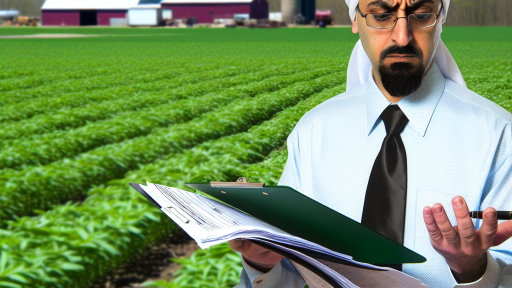Definition and Importance of Agricultural Export Laws
Agricultural export laws govern the international trade of agricultural products.
These laws aim to ensure fair practices and compliance with international standards.
They play a vital role in protecting national interests and agricultural producers.
Understanding Agricultural Export Laws
Agricultural export laws encompass regulations and policies related to exporting food and raw materials.
They cover various aspects including safety, quality, and labeling standards.
Compliance with these laws is crucial for accessing foreign markets.
The Role of Regulatory Bodies
Regulatory bodies enforce agricultural export laws on behalf of the government.
They conduct inspections to ensure that products meet safety and quality requirements.
For example, the Food and Drug Administration (FDA) in the United States oversees food exports.
Additionally, the U.S. Department of Agriculture (USDA) monitors agricultural trade practices.
Significance of Compliance
Compliance with agricultural export laws is essential for building international trade relationships.
It enhances the credibility of agricultural products in global markets.
Moreover, non-compliance can lead to penalties, loss of market access, and reputational damage.
Impact on Economic Growth
Agricultural export laws contribute to the economic growth of a nation.
By facilitating trade, they support job creation in agriculture and related industries.
Transform Your Agribusiness
Unlock your farm's potential with expert advice tailored to your needs. Get actionable steps that drive real results.
Get StartedFurthermore, compliant exports can lead to increased foreign investment.
Historical Context of Agricultural Export Regulations
Origins of Agricultural Export Laws
Agricultural export laws originated in the early 20th century.
Countries aimed to regulate the flow of food and agricultural products.
These regulations addressed trade issues and domestic food security.
Impact of World Wars
World War I significantly affected agricultural exports.
Demand for food surged, leading to increased export controls.
Governments prioritized supply stabilization during this period.
World War II further intensified these regulations.
Nations implemented strict measures to ration resources.
The Rise of Global Trade Agreements
The post-war period saw the establishment of international trade agreements.
These agreements aimed to facilitate global agricultural trade.
The General Agreement on Tariffs and Trade (GATT) played a crucial role.
It set rules for agricultural subsidies and export restrictions.
Shifts in Agricultural Policy Through the Decades
The 1960s and 1970s experienced significant changes in agricultural policy.
Developed nations began subsidizing their agricultural sectors.
This led to competitive pricing on the global market.
Emerging economies also joined the agricultural export scene.
Current Trends and Regulatory Frameworks
Today, agricultural export laws are shaped by sustainability concerns.
Regulations now address environmental impacts and labor practices.
Countries also consider food safety in their export policies.
For instance, the European Union has stringent food safety standards.
The Role of Technology in Agricultural Exports
Technological advancements greatly influence agricultural regulations.
Farmers now utilize precision agriculture to enhance productivity.
This innovation affects export quality and compliance with standards.
Showcase Your Farming Business
Publish your professional farming services profile on our blog for a one-time fee of $200 and reach a dedicated audience of farmers and agribusiness owners.
Publish Your ProfileAdditionally, digital platforms streamline trade processes.
Key International Agreements Affecting Agricultural Exports
WTO Agreements
The World Trade Organization plays a pivotal role in agricultural exports.
It establishes guidelines for trade regulations worldwide.
Members commit to reducing trade barriers and subsidies.
This promotes fair competition among exporting countries.
Additionally, the Agreement on Agriculture addresses trade in agricultural products.
Free Trade Agreements
Free trade agreements (FTAs) significantly influence agricultural exports.
For example, the North American Free Trade Agreement facilitated trade among the U.S., Canada, and Mexico.
These agreements often eliminate tariffs on agricultural products.
As a result, they increase market access for exporters.
Moreover, recent agreements emphasize sanitary and phytosanitary measures.
Bilateral Trade Agreements
Bilateral trade agreements target specific countries for enhanced trade.
Such agreements can reduce or eliminate tariffs on agricultural products.
For instance, the U.S. has signed several bilateral agreements with key partners.
These agreements often focus on specific agricultural sectors.
In turn, they open new markets for U.S. farmers and exporters.
Regional Trade Agreements
Regional trade agreements also affect agricultural exports significantly.
These agreements involve multiple countries within a specific region.
The European Union exemplifies a successful regional trade model.
It creates a single market for agricultural goods among member states.
In such arrangements, members benefit from increased trade and cooperation.
Multilateral Environmental Agreements
Environmental agreements can indirectly impact agricultural exports.
They often include regulations regarding sustainable practices.
For instance, the Convention on Biological Diversity emphasizes sustainable agriculture.
Countries commit to practices that protect biodiversity.
As a result, adherence to these agreements can improve marketability.
Delve into the Subject: Benefits of Trade Policies for Farmers
Overview of National Agricultural Export Policies
Importance of Agricultural Exports
Agricultural exports play a vital role in the economy.
They enhance trade balances and create jobs.
Additionally, these exports support local farmers and stimulate rural development.
Regulatory Framework
National agricultural export policies establish guidelines for trade.
These policies are influenced by international agreements.
Furthermore, they consider domestic agricultural conditions.
Each country has specific regulations to control exports.
International Trade Agreements
Various trade agreements shape agricultural export policies.
For example, the North American Free Trade Agreement promotes trade between Canada, Mexico, and the U.S.
Similarly, the World Trade Organization regulates international trade rules.
These agreements often eliminate tariffs on agricultural products.
Domestic Policies
Domestic policies ensure food security and support farmers.
Subsidies encourage agricultural production for export.
Showcase Your Farming Business
Publish your professional farming services profile on our blog for a one-time fee of $200 and reach a dedicated audience of farmers and agribusiness owners.
Publish Your ProfileIncentives help farmers access international markets easily.
Additionally, regulations may limit exports during domestic shortages.
Challenges in Agricultural Exports
Agricultural export policies face several challenges.
Market fluctuations often impact prices and demand.
Weather events can disrupt supply chains significantly.
Moreover, geopolitical tensions can create barriers to trade.
Future Trends
The future of agricultural exports looks promising.
Technological advancements improve production efficiency.
Moreover, sustainable practices are gaining traction globally.
These trends could lead to enhanced exports in diverse markets.
Find Out More: Essential Documentation For Organic Certification
Role of Tariffs and Trade Barriers in Agricultural Exports
Introduction to Tariffs and Trade Barriers
Tariffs are taxes imposed on imported goods.
They increase the cost of foreign products.
This practice protects domestic farmers from competition.
Trade barriers include regulations that restrict imports.
These barriers can take many forms.
Impact of Tariffs on Agricultural Exports
Tariffs significantly affect the pricing of agricultural products.
High tariffs can lower demand for imported items.
Consequently, domestic producers may benefit from reduced competition.
However, tariffs can also provoke retaliatory measures.
Such measures can lead to escalating trade tensions.
Types of Trade Barriers
Non-tariff barriers are prevalent in agricultural trade.
These include quotas that limit the quantity of imports.
Additionally, strict sanitary and phytosanitary standards apply.
These standards ensure products meet health requirements.
However, they can also be used to protect local industries.
Case Studies of Tariffs Effect
The U.S.-China trade war offers valuable insights.
High tariffs on U.S. soybeans led to a sharp decline in exports.
As a result, American farmers faced significant losses.
Conversely, Chinese soybean imports from Brazil increased.
This case illustrates the profound impact of tariffs on trade flows.
Future Considerations in Agricultural Trade
Trade policies will continue to evolve with global dynamics.
Farmers must adapt to changes in tariff regimes.
Increased market access remains a priority for many nations.
Meanwhile, sustainability practices will influence future regulations.
Ultimately, the landscape of agricultural exports will keep changing.
Delve into the Subject: Essential Agricultural Labor Regulations

Impact of Export Laws on Domestic Agriculture and Economy
Overview of Export Regulations
Export laws regulate the trade of agricultural products internationally.
These regulations aim to ensure food safety and quality standards.
Countries implement these laws to protect their agricultural sectors.
Showcase Your Farming Business
Publish your professional farming services profile on our blog for a one-time fee of $200 and reach a dedicated audience of farmers and agribusiness owners.
Publish Your ProfileAs a result, they maintain competitive advantages in global markets.
Effects on Domestic Farmers
Export laws significantly impact the income of domestic farmers.
Strict regulations can increase compliance costs for farmers.
Additionally, these laws may limit market access for certain products.
Farmers must adapt their practices to comply with changing regulations.
Consequently, some farmers may face challenges in maintaining profitability.
Influence on Agricultural Pricing
Export laws can affect the pricing structure of agricultural goods.
These regulations often lead to fluctuations in supply and demand.
High compliance costs may force farmers to increase their prices.
Furthermore, demand in foreign markets can influence domestic pricing.
This dynamic can result in higher prices for consumers at home.
Impact on the Economy
Export laws play a critical role in shaping the national economy.
They can create opportunities for economic growth in the agricultural sector.
Exporting agricultural products boosts national income and employment rates.
Conversely, restrictive laws might hinder growth and innovation.
Balancing these regulations is crucial for sustaining economic health.
Long-Term Effects and Future Trends
Long-term impacts of export laws may include changes in farming practices.
Farmers may invest more in sustainable and compliant agricultural methods.
Additionally, technological advancements can help streamline compliance.
In the future, policymakers will need to consider these nuances.
Adaptable and innovative regulations can foster a healthier agricultural sector.
Gain More Insights: Key Labor Law Requirements for Farms
Compliance and Legal Challenges in Agricultural Exports
Understanding Regulatory Requirements
Agricultural exporters must navigate various regulatory requirements.
These regulations often vary by product and destination country.
Compliance involves understanding local, national, and international laws.
Import permits and export certifications are crucial elements.
Documentation must be accurate and timely to avoid delays.
International Trade Agreements
Many agricultural exports are influenced by international trade agreements.
These agreements often dictate tariff rates and import quotas.
Exporters should stay informed about changes in trade policies.
Understanding the implications of these agreements can provide a competitive edge.
Challenges Facing Exporters
Exporters face numerous challenges in achieving compliance.
Varying regulations among countries can complicate the export process.
Additionally, exporters may encounter logistical issues.
Here are some common challenges:
- Shifting political climates impacting trade relations.
- Inconsistencies in product standards and safety regulations.
- Language barriers making communication difficult.
Legal Liability and Risk Management
Exporters should be aware of potential legal liabilities.
Non-compliance can lead to severe penalties or fines.
Risk management strategies are essential to mitigate these risks.
Consider consulting with legal experts in agricultural exports.
Regular audits can ensure adherence to regulatory requirements.
Showcase Your Farming Business
Publish your professional farming services profile on our blog for a one-time fee of $200 and reach a dedicated audience of farmers and agribusiness owners.
Publish Your ProfileBest Practices for Compliance
Developing a strong compliance program is essential for exporters.
Here are some best practices to follow:
- Stay updated on regulatory changes.
- Invest in training for staff on compliance issues.
- Implement robust record-keeping systems.
These practices can significantly reduce the risk of non-compliance.
Future Trends in Agricultural Export Legislation
Increasing Focus on Sustainability
Governments are prioritizing sustainable agricultural practices in export laws.
This trend reflects a growing awareness of environmental impacts.
Therefore, legislation will increasingly promote organic farming standards.
Additionally, countries may encourage the use of renewable resources.
Producers will need to adopt eco-friendly methods to meet new requirements.
Technological Innovations
Digital technology is reshaping agricultural export regulations.
Smart farming techniques enhance productivity and supply chain efficiency.
As a result, regulatory frameworks will incorporate tech innovations.
For instance, blockchain can improve traceability in agricultural exports.
Consequently, transparency will become a key focus for regulations.
Trade Agreements and Global Cooperation
A shift towards international collaboration is notable in export legislation.
New trade agreements will likely emphasize agricultural standards and compliance.
Countries will work together to harmonize regulations for smoother trade.
Such cooperation will facilitate access to global markets for exporters.
Moreover, countries may negotiate environmental protections within these agreements.
Health and Safety Standards
Health regulations will play a critical role in future agricultural exports.
Stricter safety standards may emerge to protect consumers and the environment.
Exporters will need to ensure compliance to avoid trade barriers.
This trend could involve enhanced inspections and certifications.
In addition, there may be a stronger focus on labeling and information transparency.
Adapting to Climate Change
Legislation will increasingly address climate change impacts on agriculture.
Regulators may require adaptations to changing weather patterns and growing conditions.
Additionally, policies may encourage innovations in climate-resilient crops.
Such changes will aim to safeguard food security in a volatile environment.
Exporters must stay informed about these evolving legislative measures.




